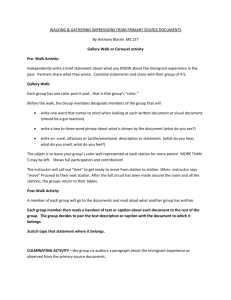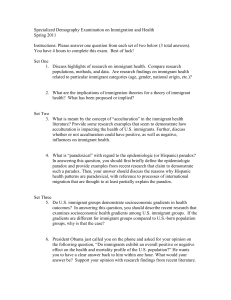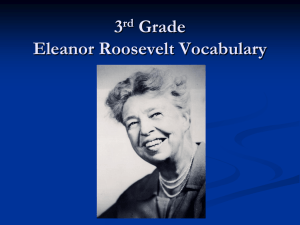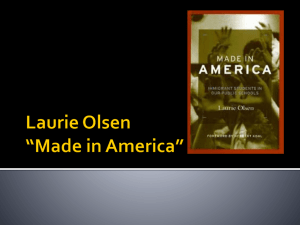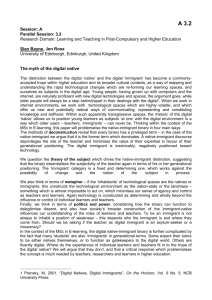Running head: ACADEMIC PERFORMANCE
advertisement
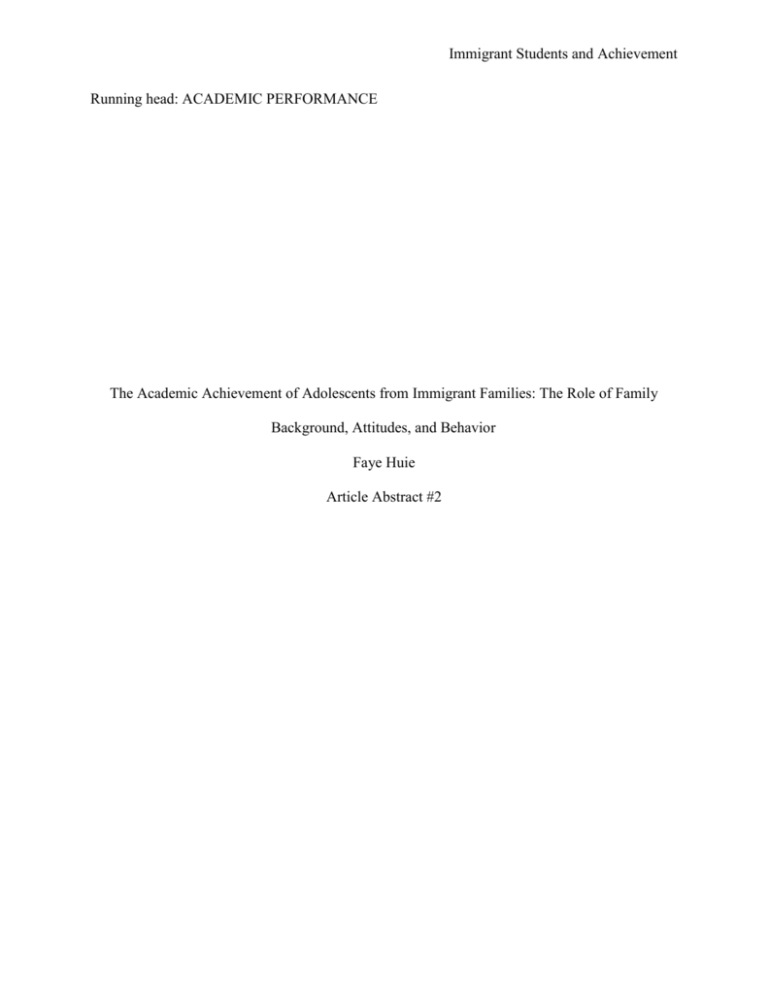
Immigrant Students and Achievement Running head: ACADEMIC PERFORMANCE The Academic Achievement of Adolescents from Immigrant Families: The Role of Family Background, Attitudes, and Behavior Faye Huie Article Abstract #2 Immigrant Students and Achievement The Academic Achievement of Adolescents from Immigrant Families: The Role of Family Background, Attitudes, and Behavior The main purpose of this article was to explore the ways in which family background, parental attitudes, peer support, and student personal attitudes and behaviors towards education influence students from immigrant families’ academic achievement (Fuligni, 1997). Specifically, Fuligni (1997) wanted to examine the magnitude of the influence on achievement between all the aforementioned variables as well as look at the different patterns across multiple generations and ethnicities. In this article abstract, I will first summarize the major findings of Fuligni (1997) and my analyses on the approach that Fuligni (1992) used to examine the influences on achievement in immigrant students. I will then reflect on my own personal insights as a first generation AsianAmerican student and discuss the implications of this research. Fuligni (1997) attempts to examine how background and psychosocial factors influence achievement in mathematics and English between students from immigrant (e.g., first and second generation students) and nonimmigrant (e.g., third generation or greater students) families. Socioeconomic status (SES) and English language use at home were considered as family background variables. Study time, value of overall achievement and between academic domains, and educational aspirations were analyzed as personal psychosocial variables. In addition, students’ perceived parental and peer attitudes in achievement, parental educational expectations of their children, and their personal educational aspirations were also examined. The total number of students who participated in this study was 1,341 tenth, eighth, and sixth grade adolescents. Fuligni (1997) found that students from first and second generation immigrant families earned higher grades in both mathematics and English than students from third generation immigrant families. Though SES was related to achievement, it did not Immigrant Students and Achievement contribute a substantive amount of variance in explaining achievement differences between generational statuses. Overall, Fuligni (1997) found that first generation students were more likely to achieve higher than their second and third generation peers, with the exception of third generation Latino students who achieved higher in math than first generation Latino students. In terms of perceived parental values, peer support, and other psychosocial variables, first generation students reported more adaptive viewpoints than their second and third generation peers. Fuligni (1997) also found that East Asian and Filipino students generally reported higher parental expectations, peer support, academic attitudes, and study time than their Latino and European counterparts. Finally, Fuligni (1997) found that across all ethnicities and generations, students’ personal values and study time significantly predicted achievement above and beyond all other variables. Fuligni (1997) concludes that students of immigrant families who are proficient in English are adapting well to their academic settings and perform at the same or higher level than students who come from nonimmigrant and established families. Fuligni (1997) presents an interesting analysis of how students from immigrant families are adapting to the academic demands of their new American schools. I expected that personal student attitudes and behaviors would be the most powerful predictor of achievement above all other variables. However, I did not expect that first and second generation students whose English was not the predominate language at home would achieve higher than their peers whose main language was English. Although the findings were enlightening, a few flaws exist: a) the survey methods used to collect data, b) generalizing the analyses to overall first/second generation students, and c) not including students who are not proficient in English. All the surveys used with the exception of student personal values of English and mathematics were created by the researcher. There was no explanation of how the scale was Immigrant Students and Achievement created, what the items were based upon, or any attempt to validate the instrument. The only information the Fuligni (1997) provides for his readers are the reliability coefficients, which were not that reliable for some of the scales (e.g., “range (for alpha) = .63” (p 354)). Although the findings do make sense theoretically, I wonder if the results would be different if the survey measures were further analyzed. I must say that I was not surprised that Asians were found to have more adaptive attitudes and behaviors towards education than Latinos and Europeans. However, when ethnicity was disregarded and generational status was analyzed, the results suggested that generally, first and second generation immigrants had more adaptive psychosocial attitudes and behaviors than the later generations. I think that Fuligni (1997) must take into account the differences between ethnicities in order to accurately and effectively draw conclusions. This is especially important to consider when the psychosocial and academic patterns across generational statuses of Latinos are found to be less adaptive than Asians. With this said, I think Fuligni (1997) should have placed more emphasis on ethnicity when analyzing the results. Something more than generational status is occurring which needs to be taken into major consideration instead of lumping the entire population together and concluding that early generational status students have been adapting well to academics in the U.S. I still do not completely understand why students who could not speak English proficiently were not included in the study. This study is, in fact, about students from immigrant families and one cannot expect all immigrant students to be proficient in English. There was no strong rationale as to why those immigrant students were not included. Ultimately, Fuligni (1997) concludes that students from immigrant families are adapting well, however, is this conclusion truly accurate when Fuligni (1997) does not include the students who are not Immigrant Students and Achievement proficient in English? I do not think that Fuligni (1997) can draw conclusions about “students from immigrant families” if he disregards the immigrant students who are not proficient in English. Additionally, I am surprised that all first generation students were able to speak English fluent enough to answer survey questions in English. I feel that there is a substantial amount of information missing about the status of students’ English proficiency skills. It would have been important to know how long the students were enrolled in an English speaking school or if they were enrolled in ESOL classes. This class has introduced me to so many different sociocultural facets of education that it was difficult focusing on the issues presented in this article. All variables examined in this article are influenced by issues of parental involvement, peers, SES, and school climate. It was personally difficult to digest research that found parental involvement as a critical factor in student achievement. I feel that Fuligni (1997) approached the relationship between parents and students in a more appropriate manner (i.e., examining the influence of parent values and expectations instead of the direct relationship between parent and child), especially in the context of immigrant and diverse students. Also, SES has been found to have little influence on achievement across the different articles that have been assigned while student values and behaviors (i.e., motivation and self-regulation) continue to be major players in achievement. This in itself has strong implications on the approach that we educators need to use to motivate and self-regulate our students. This article relates to me personally because I am a child of first generation immigrants. I have noticed that for Asian-Americans, those who are first generation students tend to value education more because of the difficulties their parents have endured to provide a “better life.” Families that have been in the States for generations tend to be more “Americanized” and do not Immigrant Students and Achievement share the same values and attitudes on education than those who are children of first generation immigrants. The Asian culture itself places strong and high values on education which first generation immigrants may be more likely to pass on to their children. Unfortunately, as generations progress the cultural values that were once so strong become more accommodated into the current culture. I feel that this process of accommodating one’s culture into another weakens the student’s cultural roots. This may be a major reason why educational values and performance tend go down in further generations, especially with regards to Asian-Americans. Immigrant Students and Achievement References Fuligni, A. J. (1997). The academic achievement of adolescents from immigrant families: The roles of family background, attitudes, and behavior. Child Development, 68, 351-363.

